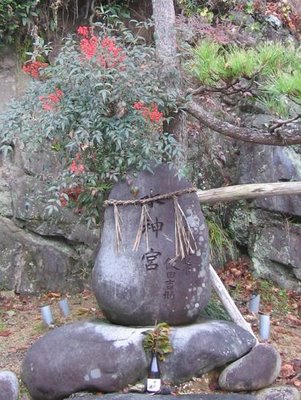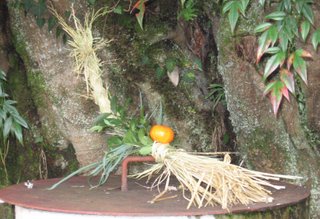::::::::::::::::::::::::::::::::::::::::::::::::::::::::::::::::::::::::::::::::::::::::::::::::::::
Water, drinking water (nomimizu のみみず 水)
***** Location: Japan
***** Season: Various, see below
***** Category: Earth / Humanity
*****************************
Links only to my pages.
Explanation
Fresh clear drinking water to prepare food and drinks, this is the most important necessity for humans to live !
Because of plenty of rainfall during the rainy season from mid-June to mid-July, Japan is blessed with many wells and springs and even has a ranking of the 100 best springs (meisui hyakusen 銘水百選).
Areas with rice wine or tofu production or wasabi plantations relay on the fresh water coming abundantly out of the mountains. Many sake companies have their own well.
Rural farmers in the mountains could not survive without constant water supply for the rice paddies. Most farmers homes have a memorial stone for the God of Water in the backyard, sometimes just a large stone with the Chinese character for water, mizu 水 carved in it. You pray there for water during a drought but also for protection from flood waters during a typhoon. At some Shinto shrines, for example, a black horse was offered to induce rain and a white horse to make a long rain stop.
In the rice paddies, seasonal rituals are performed in honor of the deity of water, mizu no kamisama, before letting the water enter into the watering systems.
The city of Edo could not have developed without a delicate system of wells to provide drinking water for the population. There is even a part named . "Ochanomizu" . , meaning "water for tea", where the tea water for the Shogun was taken from.
Kyoto was blessed with a natural system of waterways to sustain the people. Many of the old tea ceremony masters families have their own well for the tea ceremony, which, by the way, translates as "hot water for tea", cha no yu 茶の湯.
Many famous wells have been subject to poetry since olden times. Clear Water, SHIMIZU, KIYOMIZU 清水 is part of the name of some temples and shrines of Japan.
Water is served free with any meal at a restaurant. Many people make weekly trips with large containers to a famous well nearby to draw water for their daily cooking and tea preparation.
And thanks to the vulcanic acitvities we have the natural hot water from the many onsen, the hot springs. This water is also used for cooking. Vegetables in a sack are put into the boiling water until they are done. Many regions also sell eggs boiled in hot spring water", onsen tamago, as a local speciality. The yellow inside has a half-boiled quality, which is especially favored. Because of the sulfuric compounds of some hot springs these eggs get a black shell in the process.
. eggs boiled in hot spring water .
Different to other countries in Asia, tab water is usually drinkable everywhere. Mineral water is just beginning to be sold here.
::::::::::::::::::::::::::::::::::::::::::::::::::::::::::::::::::::::::::::::::::::::::::::::::::::

Stone Memorial for the God of Water
winter in town –
the stone memorial of the
God of Water
Gabi Greve, Katsuyama 2005
There are many rituals and ceremonies concerning WATER in Japan. Here is a list of some I have covered elsewhere:
First Water, "young water" (wakamizu)
Including more kigo of this ceremony.
First water drawing is most important for the tea ceremony and some temple and shrine rituals.
Drawing Sacred Well Water,
O-Mizutori, Omizutori, お水取り
Nara
Suijinsama 水神様 <> The Gods of the Four Elements, the Water God
..... SUIJIN God of Water
Daigosui 醍醐水 Water from the temple Daigoji and
Gosan Ryori, gosan ryoori 醐山料理, prepared with this water.
Akai no Mizu 閼伽井 / Kannon Bosatsu Water 観音水
From temple Iwakura Daiun-ji, Kyoto. For healing mental illness.
Other items concerning WATER
Kappa 河童 <> The Water Goblin
Kettle, tea kettle (kama, chagama, tetsubin)
Water kettle, water pot.
Rain Rituals (amagoi) Rain Dance, Rain Prayer, Regenzauber
Sound of Water (mizu no oto) Japan
a famous haiku phrase
Sprinkling Water (uchimizu, Japan)
Suiteki 水滴 water drippers for calligraphy
Taki 滝 <> Waterfalls named Daruma
..... TAKI ... Waterfalls and Fudo Myo-o
..... Water in various kigo
including: clear water in summer (shimizu), water birds, water lily, water melon, waterfall, dripping water and many more
Water Shortage (Tropics)
::::::::::::::::::::::::::::::::::::::::::::::::::::::::::::::::::::::::::::::::::::::::::::::::::::
quote
The Blessings of Water
IWAI Hiromi Professor of Folklore,
Tezukayama University
Mikunari God, Kawakami God
Water is a blessing from another world. It flows down the sides of mountains, through villages, and finally into the sea. Because water is indispensable to villagers farming the land, since ancient times, Japanese have prayed to gods to ensure water for their villages.
Mikumari, one of these gods, presides over running water. The "kumari" portion of the name comes from the word "kubari", which means distribution.
The god's name is therefore often found in the names of shrines dedicated to water gods and located at the sources of rivers and watersheds. In terms of folklore, the Kojiki states that the gods Ame-no-mikumari and Kuni-no-mikumari appeared as the children of two other gods, Haya-akitsu-hiko and Haya-akitsu-hime. The Engi Shiki mentions four "mikumari" shrines"Katsuragi Mikumari Shrine in Katsuragi-gun, Yoshino Mikumari Shrine in Yoshino-gun, Uda Mikumari Shrine in Uda-gun, and Tsuge Mikumari Shrine in Yamabe-gun-in Yamato-no-kuni (today's Nara Prefecture) along with Take Mikumari Shrine in Ishikawa-gun in Kawachi-no-kuni (Osaka Prefecture) and Ame-no-mikumari Toyoura-no-mikoto Shrine in Sumiyoshi-gun, Settsu-no-kuni (also in Osaka Prefecture). As sacred distributors of water, the mikumari were also often the object of prayers for rain. The Shoku-nihongi tells that in April of 698, the second year of Emperor Monmu, a horse was presented to the god Yoshino Mikumari as a rain offering.
The god Kawakami also presides over water. The Engi Shiki mentions the god Niu-Kawakami in Yamato-no-kuni. Today's Niu Kawakami Shrine is made up of three sites, Kami, Naka, and Shimo, wherein "kami" refers to the top, "naka" to the middle, and "shimo" to the bottom. The Kami Shrine mainly deifies Takaokami-no-kami, while Naka Shrine deifies Mitsuhahime-no-kami and Shimo Shrine Kuraokami-no-kami. These kami (gods) all preside over water and have been worshiped as rain gods since ancient times.
In Kyoto, Kibune Shrine deifies Takaokami-no-kami, who is worshiped as a rain god. It is described in the Shoku-nihongi, the Nihon-koki, the Shoku-nihon-kok , the Montoku-tenno Jitsuroku, and the Sandai Jitsuroku that from 765, the seventh year of Tempyohoji, people prayed almost every year to Niu-Kawakami and Kibune for rain. They are said to have offered a black horse when they wanted the rains to start and a white horse when they wanted the rains to end because it was believed that the spirit of the gods descend to earth on a horse. Black is the color for casting a rain spell as it symbolizes dark clouds bringing rain. In contrast, white is the symbol of the bright sun. These prayers were held as national events.
Water for Purification
Water flowing down from mountains empties into the sea. Because the ancient Japanese believed that the sea was another world where gods lived, touching seawater was called "misogi", or purification of the self. In preparation for welcoming the spirit of the gods and holding a feast, people had to avoid impurity and perform monoimi (abstaining from food and drink for a period in order to purify oneself.) while waiting for the day to arrive; misogi was performed for this purpose.
People believed that seawater, a way to connect with that other world, was a strong purifier, so misogi originally involved bathing in seawater. People in Kyushu have long practiced customs known as "paddling seawater," "kicking seawater" and "taking seawater." And in a fishing village in Shima, Mie Prefecture, the custom is for villagers to bathe together in the sea on New Year's Eve. It is said that bathing in the sea around the festival days of Sumiyoshi Shrine in June has the miraculous effect of prolonging life; this activity has been named "Sumiyoshi-no-o'yu" (Sumiyoshi Bath).
And even those from mountain villages who go all the way down to the beach to do misogi have names for this journey: "hama-ori" (going down to the beach) and "hama-iki" (going to the beach). Today, small mounds of salt are sometimes seen in public locations, a reminder of misogi with seawater.
The Engi Shiki tells us that when people went to worship at Ise Shrine, they performed their misogi at landings along the Miyagawa River, the largest river in Iga-no-kuni (Mie Prefecture). During the Edo period, Many people traveled to the shrine by crossing the Miyagawa River by boat. Reaching the other side of the river meant entering the precincts of the gods, so landings on the shrine side of the river with such names as "Sakura-no-watashi (Cherry Tree Landing)," "Yanagi-no-watashi (Willow Landing)," "Iso-no-watashi (Seashore Landing)," and "Kamijo-no-watashi (Kamijo Landing)" were designated sacred places in which people could perform misogi before they actually entered the precincts of the gods. Fishing for ayu (sweetfish) in the sacred Miyagawa River was prohibited until the Edo period because the fish were used as offerings during shrine services.
In areas far from the sea, people began to perform misogi in rivers, believing that seawater entered the rivers during high tides. Thus the act of misogi spread inland. People also grew to believe that wells led to the other world, so well water also came to be used as water for misogi.
source : www.kippo.or.jp / Iwai Hiromi
*****************************
HAIKU
WATER just like that (mizu, sui 水 ) is not a kigo in Japan but a nonseasonal topic.
But since water is a constant necessity throughout the year, there are many detailed phenomenon used as kigo for it. And in olden times with no tabwater, this comodity was really important for the continuation of life.

New Year decoration of a rural well in Japan
© Gabi Greve, January 2007
WATER, a list of related KIGO
MY ONSEN 温泉 . おんせん Hot Springs of Japan
*****************************
Related words
***** WKD : Drinks in the seasons - SAIJIKI
[ . BACK to DARUMA MUSEUM TOP . ]
[ . BACK to WORLDKIGO . TOP . ]
:::::::::::::::::::::::::::::::::::::::::::::::::::::::::::::::::::::::::::::::::::::::::::::::::::::






No comments:
Post a Comment